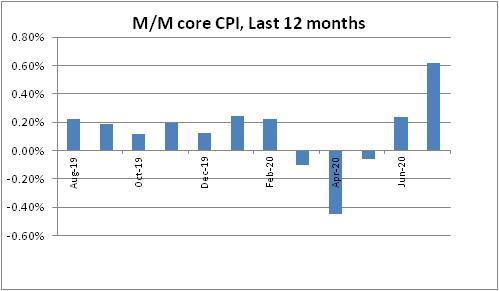posted: August 15, 2020
tl;dr: A microeconomics-based example that illustrates how price inflation can happen during a recession...
I’ve been having some debates with family members and others about what is happening in the U.S. economy as a result of the COVID-19 pandemic. Many claim that it is nearly impossible for price inflation to set in while the economy is shrinking and so many people are unemployed. Yet I believe that, for a variety of factors, the pandemic has triggered price inflation, after two decades of historically low price inflation.
Consumer demand is down. So how can prices rise?
High school economics teaches the law of supply-and-demand: lower demand forces prices lower, to clear the available supply. Farmer Bob shows up to market with 100 bushels of corn, which he would normally expect to be able to sell for $10/each. But because of "Event-C", consumer demand is lower, so he has to lower his price to $8/bushel in order to sell all 100. The Consumer Price Index (CPI) measures consumer prices, and the price of a bushel of corn has dropped from $10 to $8, so that's deflation.

July 2020 had the highest monthly core CPI increase since 1991 according to the BLS; h/t to @inflation_guy
But this example is overly simplistic, as it doesn't take into account the changes that will need to be made on the supply side. A better example is a pie shop. Every day, before Event-C, Pie Shop Owner Sally and one employee bake 100 pies which they sell for $10/each. The cost of making a pie is $7, so the owner clears $3/pie of profit, or $300/day.
Then Event-C happens, and Owner Sally discovers that she cannot sell 100 pies/day at $10/each, because total demand is down. Also because of Event-C, the manufacturing cost of a pie has increased to $8/pie, as the “Pie Producer Price Index" has risen. The apple and sugar supplies are shaky, she has to pay her worker hazard pay, she has to buy extra cleaning supplies to make her store spotless so that customers will come in and buy, etc. If she made 100 pies, she might be able to sell all 100 of them at a price of $8, because overall demand is down. But then she's spinning her wheels and not making any money.
So Sally will try to rebalance her business and find a new supply figure and price point that still yields a profit. She clearly needs to produce fewer pies. By producing fewer, she can hopefully find a higher price point that still yields a profit.
Remember that the selling price is really a "clearing" price that clears all the available supply. Both before and after Event-C, there actually are people who are willing to pay more than the clearing price for a pie. There are a handful of people who are happy to pay $15, and more who are willing to pay $12. Before Event-C, there were 100 people who were willing to pay $10, and after Event-C there are 100 who are willing to pay $8.
So the pie shop owner lays off her worker and makes only 40 pies/day. Now she tries to find a price that will clear (sell) 40 pies/day. She could sell 100 at $8; maybe she can sell 40 at $11/pie or $12/pie. She'll experiment, trying to find a formula that works. If she can sell 40 pies/day at $11/pie, with a cost of $8/pie, she'll clear $120/day in profit. The pie shop is not as profitable as before Event-C, but at least the owner's not spinning her wheels. CPI measures consumer prices, and the price of a pie has increased from $10 to $11, so that's inflation.
If the pie shop scenario prevails across the economy, what happens to the economic metrics?
Gross Domestic Product (GDP) goes down, because a lower total dollar value of goods is produced.
Unemployment goes up, because fewer workers are needed.
CPI goes up, because consumer goods cost more.
Business (corporate) profits go down, causing the stock market to go down eventually, when investors tire of paying high P/E (Price-to-Earnings) multiples.
In short, the result is a recession (or depression) with high unemployment and price inflation. When both unemployment and inflation are high, that’s stagflation. The key is that Event-C raises the cost of production across a broad swath of the economy. In the 1970s, when we last had stagflation, Event-C was an oil shock. In 2020, Event-C is a pandemic.